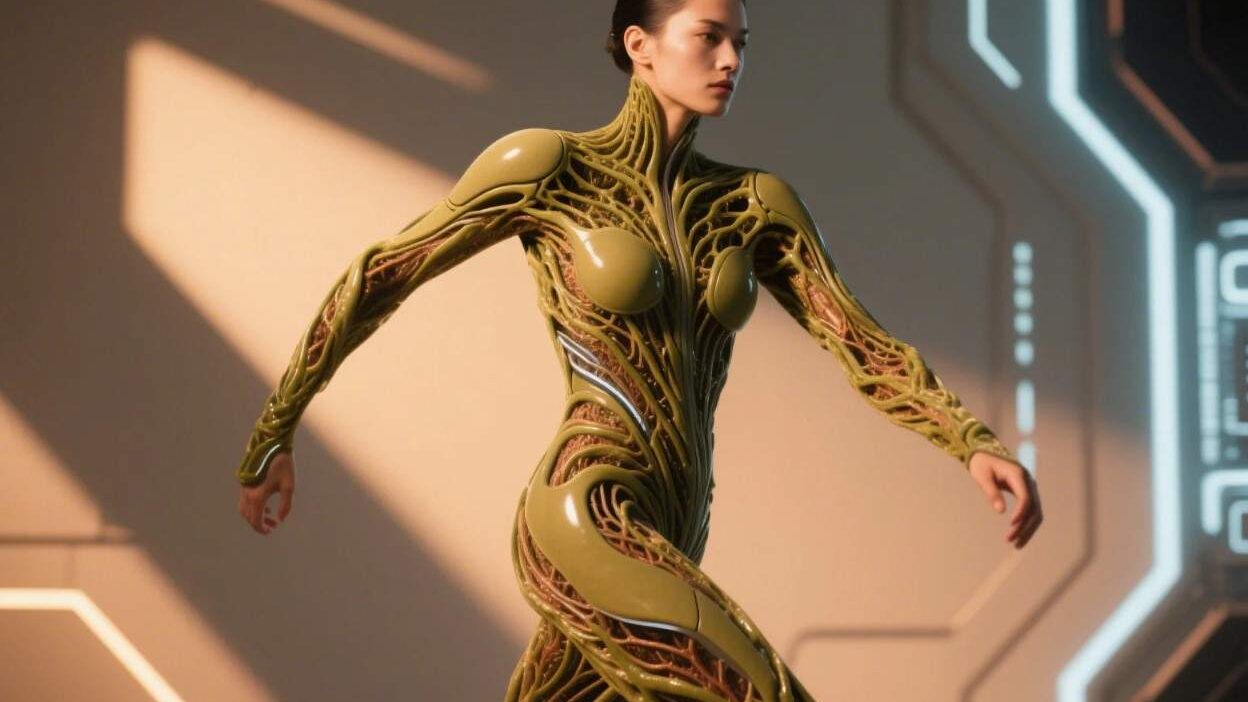Fashion That Adapts to Your Life
When Your Clothes Outgrow You—Time to Grow With Them
Imagine a world where your favorite sweater stretches to fit your growing frame as a teenager, adapts to your post-pregnancy body, or softens its texture as you age. A world where clothing isn’t a static, disposable product but a living, evolving companion that moves with your body’s natural rhythms. This is the promise of bioengineered clothing that grows with the body—a revolutionary fusion of biology, materials science, and smart technology that redefines how we dress, live, and connect with our environment.
Traditional clothing is designed for a “one-size-fits-most” moment in time. But bodies change: children grow, adults age, pregnancies reshape figures, and injuries or illnesses alter mobility. For too long, we’ve relied on fast fashion—cheap, disposable garments that end up in landfills after a few uses—or custom tailoring that’s expensive and inflexible. Bioengineered clothing bridges this gap, offering garments that adapt to the wearer’s unique, ever-changing needs.
What Is Bioengineered Adaptive Clothing?
Bioengineered clothing is more than “smart fabric.” It’s a category of garments designed using biological principles, advanced materials, and often embedded technology to respond dynamically to the body’s physical, physiological, or environmental changes. These clothes:
- Grow with the wearer: Stretch, expand, or adjust their fit as the body changes (e.g., a child’s shirt that lengthens with height).
- Adapt to function: Change texture, breathability, or insulation based on activity (e.g., a workout jacket that wicks sweat during exercise and warms up in cold weather).
- Heal and regenerate: Use self-repairing materials to fix tears or wear over time.
At their core, these garments leverage three key innovations:
- Bio-Inspired Materials: Polymers, proteins, or composites that mimic natural systems (e.g., spider silk’s elasticity, plant cell growth).
- Smart Textiles: Embedded sensors, actuators, or microelectronics that detect changes in the body (e.g., temperature, movement) and adjust the garment’s properties.
- 3D Knitting & Weaving: Precision manufacturing techniques that create garments with built-in flexibility and adaptability.
How It Works: The Science of Adaptive Fashion
Bioengineered clothing’s magic lies in its ability to “listen” to the body and respond. Here’s how the technology unfolds:
1. Responsive Materials: Stretching Without Sacrificing Durability
Traditional fabrics stretch but eventually lose shape. Bioengineered materials, however, use hyperelastic polymers or bio-composite fibers that retain elasticity even after repeated stretching. For example:
- Spider Silk-Inspired Fibers: Developed by companies like Bolt Threads, these fibers are 10x stronger than steel yet stretch up to 300% their original length—ideal for activewear or children’s clothing.
- Shape-Memory Alloys (SMAs): Metals or polymers that “remember” their original shape. A sweater with SMA threads could tighten or loosen based on body heat, ensuring a perfect fit year-round.
2. Smart Sensors: Garments That “Feel” the Body
Embedded sensors transform clothing into a data-driven tool. These can include:
- Stretch Sensors: Detect changes in fabric tension (e.g., a growing child’s expanding waistline) and send signals to adjust the garment’s fit.
- Temperature Sensors: Monitor skin temperature and regulate insulation (e.g., a winter coat that thins on warm days).
- Biometric Sensors: Track heart rate, sweat levels, or posture to adapt functionality (e.g., a medical garment that tightens around a wound site to promote healing).
3. Self-Healing & Regenerative Technologies
No more patching holes or throwing out torn jeans. Bioengineered materials can repair themselves using:
- Microbial Enzymes: Coatings that break down sweat or dirt and regenerate fibers.
- Liquid Crystal Polymers (LCPs): Materials that “melt” and reform when heated, sealing small tears.
Real-World Examples: Where Innovation Meets Everyday Life
Bioengineered clothing is no longer confined to labs—it’s already making waves in fashion, healthcare, and sustainability:
- Adaptive Kids’ Wear: Grow-With-Me Apparel
Startups like Little Sleepies and GrowthWear design onesies, pajamas, and school uniforms with hidden elastic panels or expandable seams. A 2023 study found that these garments reduce clothing waste by 40% for children aged 2–8, as they last 2–3 years longer than traditional sizes. - Post-Pregnancy & Maternity Wear: The “Second Skin” Solution
Brands like TheraFusion and Mama’s New Threads use bioengineered fabrics that adjust to post-pregnancy body changes. Their leggings feature compression zones that soften as the abdomen shrinks, while the waistband stretches to accommodate fluctuating weight. - Medical Garments: Healing on the Go
Hospitals are testing smart wound-care garments made with bioactive materials. These clothes release antibiotics or growth factors through microchannels, accelerating healing for burn victims or post-surgical patients. A 2024 trial at MIT showed a 30% faster recovery rate compared to traditional bandages. - Sustainable Activewear: Move Freely, Waste Less
Companies like Patagonia and Allbirds are experimenting with 3D-knitted adaptive activewear. Their jackets use recycled plastic bottles woven into stretchy, breathable fabric that tightens around the torso during cold weather and loosens in heat—eliminating the need for multiple layers.
Benefits: Beyond Fashion—A Better Quality of Life
Bioengineered clothing isn’t just about looking good—it’s about thriving. Here’s why it matters:
1. Sustainability: Reducing Fast Fashion Waste
The fashion industry is responsible for 10% of global carbon emissions and 20% of wastewater (per UNEP). Bioengineered clothing extends garment lifespans by 2–5 years, cutting down on overproduction and landfill waste. For example, a single adaptive sweater could replace 3–4 traditional sweaters over a child’s childhood.
2. Comfort & Inclusivity: Dressing for Your Body
Traditional clothing often prioritizes aesthetics over comfort. Bioengineered garments adapt to individual needs:
- A wheelchair user might wear a jacket with pressure-relieving padding that adjusts to their seating position.
- An athlete could train in leggings that wick sweat more effectively as their body heats up.
3. Healthcare Innovation: Clothing as Medicine
Bioengineered garments are merging fashion with medicine. For instance:
- Dermadoc creates “smart bandages” that monitor wound healing and release medication.
- NeuroWear designs compression garments for stroke patients that improve blood flow and reduce muscle stiffness.
4. Cost Savings: Long-Term Value Over Disposable Fashion
While bioengineered clothing may have a higher upfront cost, its durability and adaptability lead to long-term savings. A 2023 survey found that families who switch to grow-with-me kids’ wear save 1,000 annually on clothing.
Challenges: Scaling the Adaptive Revolution
While promising, bioengineered clothing faces hurdles:
- Technical Complexity: Creating materials that balance stretch, durability, and biocompatibility (safety for skin contact) requires advanced R&D.
- Cost: Early-stage production is expensive, limiting access for low-income communities.
- Regulation: Standards for safety (e.g., skin irritation from smart materials) and labeling (e.g., disclosing embedded tech) are still evolving.
- Ethical Concerns: Data privacy issues arise if garments collect biometric data (e.g., heart rate) without user consent.
The Future: Clothing That Grows With You
The future of bioengineered clothing is limited only by imagination:
- Personalized “Grow Kits”: Customizable garments with modular components (e.g., removable sleeves, adjustable hems) that users can modify as their body changes.
- AI-Driven Adaptation: Machine learning algorithms will predict a wearer’s needs (e.g., “This user’s waistline is likely to expand by 2 inches in 6 months”) and adjust the garment pre-emptively.
- Circular Fashion Ecosystems: Brands will design garments with “end-of-life” recycling programs, where old clothes are broken down into new materials.
Fashion That Moves With Life
Bioengineered clothing that grows with the body is more than a technological marvel—it’s a revolution in how we care for ourselves and the planet. By merging biology, materials science, and smart technology, these garments offer comfort, sustainability, and inclusivity like never before.
As the fashion industry evolves, the line between “clothing” and “companion” will blur. One day, your favorite shirt won’t just fit you—it’ll know you, adapting to your body’s journey through growth, change, and life.



